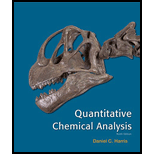
Concept explainers
(a)
Interpretation:
The given number has to be rounded to three significant figures.
Concept Introduction:
Significant Figures:
While reporting a reading of a measurement, the digits that are considered to be significant irrespective of the place of location of decimal point are called significant figures.
All the digits in a measurement except zero are considered significant, whereas zero is considered as significant only when it lies in the middle of the digit or at the end of number on the right-hand side of a decimal point.
Rounding off:
Rounding off gives a simpler numeral by maintaining the value close to its original value.
Steps for Rounding off:
- The location of rounding should be found.
- If the next digit after the rounding place is greater than 5 (i.e 5, 6, 7, 8 or 9) the value will be rounded up
- If the next digit after the rounding place is lesser than 5, (i.e 0, 1, 2, 3 or 4) the value will be rounded down.
To Round: The given number to three significant figures
(b)
Interpretation:
The given number has to be rounded to three significant figures.
Concept Introduction:
Significant Figures:
While reporting a reading of a measurement, the digits that are considered to be significant irrespective of the place of location of decimal point are called significant figures.
All the digits in a measurement except zero are considered significant, whereas zero is considered as significant only when it lies in the middle of the digit or at the end of number on the right-hand side of a decimal point.
Rounding off:
Rounding off gives a simpler numeral by maintaining the value close to its original value.
Steps for Rounding off:
- The location of rounding should be found.
- If the next digit after the rounding place is greater than 5 (i.e 5, 6, 7, 8 or 9) the value will be rounded up
- If the next digit after the rounding place is lesser than 5, (i.e 0, 1, 2, 3 or 4) the value will be rounded down.
To Round: The given number to three significant figures
(c)
Interpretation:
The given number has to be rounded to three significant figures.
Concept Introduction:
Significant Figures:
While reporting a reading of a measurement, the digits that are considered to be significant irrespective of the place of location of decimal point are called significant figures.
All the digits in a measurement except zero are considered significant, whereas zero is considered as significant only when it lies in the middle of the digit or at the end of number on the right-hand side of a decimal point.
Rounding off:
Rounding off gives a simpler numeral by maintaining the value close to its original value.
Steps for Rounding off:
- The location of rounding should be found.
- If the next digit after the rounding place is greater than 5 (i.e 5, 6, 7, 8 or 9) the value will be rounded up
- If the next digit after the rounding place is lesser than 5, (i.e 0, 1, 2, 3 or 4) the value will be rounded down.
To Round: The given number to three significant figures
Want to see the full answer?
Check out a sample textbook solution
Chapter 3 Solutions
Quantitative Chemical Analysis
 ChemistryChemistryISBN:9781305957404Author:Steven S. Zumdahl, Susan A. Zumdahl, Donald J. DeCostePublisher:Cengage Learning
ChemistryChemistryISBN:9781305957404Author:Steven S. Zumdahl, Susan A. Zumdahl, Donald J. DeCostePublisher:Cengage Learning ChemistryChemistryISBN:9781259911156Author:Raymond Chang Dr., Jason Overby ProfessorPublisher:McGraw-Hill Education
ChemistryChemistryISBN:9781259911156Author:Raymond Chang Dr., Jason Overby ProfessorPublisher:McGraw-Hill Education Principles of Instrumental AnalysisChemistryISBN:9781305577213Author:Douglas A. Skoog, F. James Holler, Stanley R. CrouchPublisher:Cengage Learning
Principles of Instrumental AnalysisChemistryISBN:9781305577213Author:Douglas A. Skoog, F. James Holler, Stanley R. CrouchPublisher:Cengage Learning Organic ChemistryChemistryISBN:9780078021558Author:Janice Gorzynski Smith Dr.Publisher:McGraw-Hill Education
Organic ChemistryChemistryISBN:9780078021558Author:Janice Gorzynski Smith Dr.Publisher:McGraw-Hill Education Chemistry: Principles and ReactionsChemistryISBN:9781305079373Author:William L. Masterton, Cecile N. HurleyPublisher:Cengage Learning
Chemistry: Principles and ReactionsChemistryISBN:9781305079373Author:William L. Masterton, Cecile N. HurleyPublisher:Cengage Learning Elementary Principles of Chemical Processes, Bind...ChemistryISBN:9781118431221Author:Richard M. Felder, Ronald W. Rousseau, Lisa G. BullardPublisher:WILEY
Elementary Principles of Chemical Processes, Bind...ChemistryISBN:9781118431221Author:Richard M. Felder, Ronald W. Rousseau, Lisa G. BullardPublisher:WILEY





